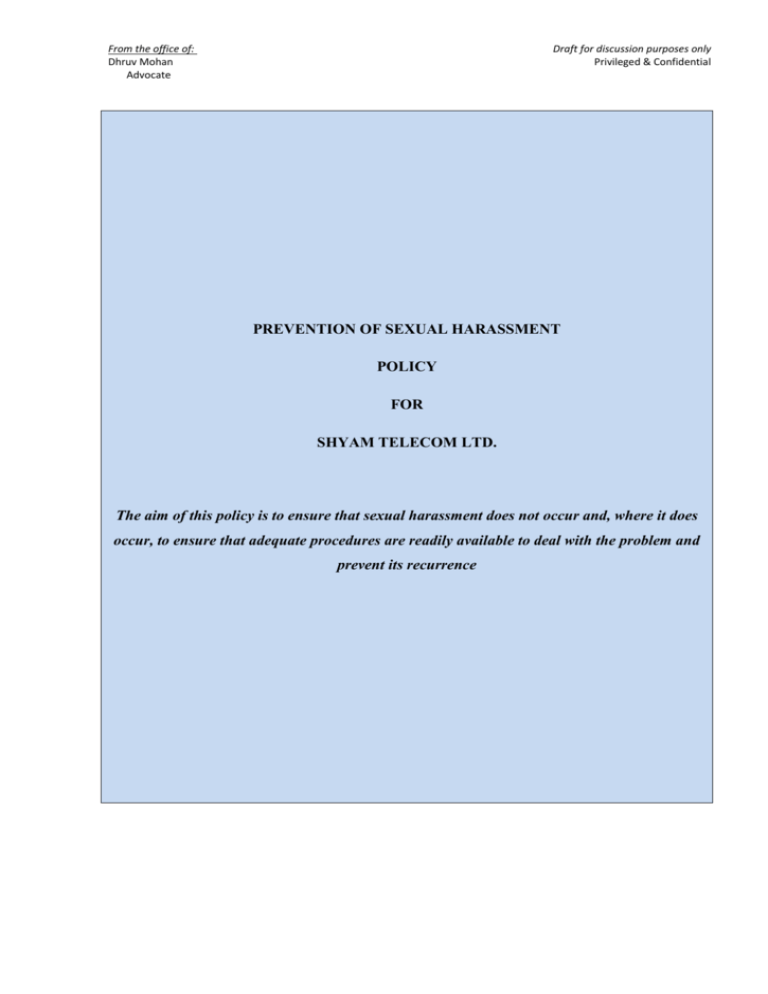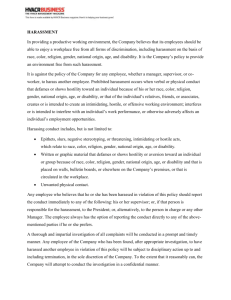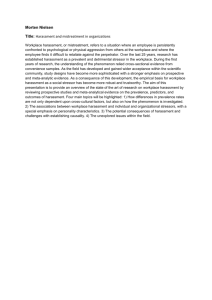
From the office of:
Dhruv Mohan
Advocate
Draft for discussion purposes only
Privileged & Confidential
PREVENTION OF SEXUAL HARASSMENT
POLICY
FOR
SHYAM TELECOM LTD.
The aim of this policy is to ensure that sexual harassment does not occur and, where it does
occur, to ensure that adequate procedures are readily available to deal with the problem and
prevent its recurrence
From the office of:
Dhruv Mohan
Advocate
Draft for discussion purposes only
Privileged & Confidential
INDEX
SR. NO
TITLE
1.
Introduction
2.
The Law
3.
Scope of the Policy
4.
Definitions
5.
Constitution of the Internal Committee
6.
Redressal Mechanism
7.
Preventive Steps
8.
Miscellaneous
9.
Annexure ‘A’
10.
Annexure ‘B’
11.
Annexure ‘C’
PAGE NO.
Prevention of Sexual Harassment Policy
Eli STL
1.
Draft for discussion purposes only
INTRODUCTION
1.1 Shyam Telecom Ltd. (“STL”) is very scrupulous about the working environment at any of
its offices. STL strives to provide a professional work environment free of sexual
harassment, exploitation and intimidation. STL also believes that all Employees (as
defined hereinafter) have the right to be treated with dignity and respect.
1.2 In accordance with the Sexual Harassment of Women at Workplace (Prevention,
Prohibition and Redressal) Act, 2013 and the Rules framed thereunder, STL has framed this
Policy on the Prevention of Sexual Harassment (this “Policy”).
1.3 The objective of this Policy is to provide the women Employees of STL a workplace, free
from harassment/discrimination and ensure that every Employee is treated with dignity and
respect. The Policy also endeavors to set expectations regarding workplace behaviour, and
provide Employees with a framework for reporting concerns.
2
THE LAW
2.1
The Supreme Court of India laid down certain guidelines (“Anti Harassment
Guidelines”) in its judgment in the case of Vishaka v State of Rajasthan (1997) 7 SCC
323 (‘Vishaka Judgment’) to formulate effective measures to check the evil of sexual
harassment of working women at all work places. The Vishaka Judgment illustratively
laid down what would constitute sexual harassment at workplace and in that regard,
specified the duties of the employer. These duties inter alia include taking initiatives
towards prevention of sexual harassment of the women employees at workplace and
creating awareness of their rights in context of such sexual harassment. Rightly
described as a landmark judgment by the National Alliance of Women, the Vishaka
Judgment laid down the foundation stone for juridical thought and process for
preventing sexual harassment of women at workplace.
2.2
The Parliament of India enacted the Sexual Harassment of Women at Workplace
(Prevention, Prohibition and Redressal) Act, 2013 (hereinafter referred to as the “Act”)
to codify the spirit and intent of the Anti Harassment Guidelines. The Act came into
force in 2013, codifying the protection available to women employees against sexual
harassment vide the Vishaka Judgment and laying down mechanisms for prevention of
sexual harassment and redressal of Complaints, beside matters connected therewith or
incidental thereto.
2.3
The Act is to be strictly observed in all workplaces. The Act derives its powers from
Article 14, 15 and 21 of the Constitution of India and is meant to be applied by all
This Policy has been issued in compliance with the Sexual Harassment of Women at Workplace (Prevention, Prohibition and
Redressal) Act, 2013.
Prevention of Sexual Harassment Policy
Eli STL
Draft for discussion purposes only
courts within the territory of India when dealing with matters involving sexual
harassment in the workplace.
3
SCOPE OF THE POLICY
3.1 This Policy shall apply to all Employees of STL whether at the office(s) of STL or
elsewhere.
3.2 This Policy shall apply to all allegations of Sexual Harassment (as defined hereinafter)
made by an Employee, against another Employee, occurring or having occurred within or
outside the premises of STL, including allegations made by Employees on overseas
programs and trainings and/or during the course of an Employee’s employment with STL.
This Policy shall apply in respect of any act of Sexual Harassment which may have been
committed in any place visited by any Employee, travel to such place having been
occasioned by or arising out of, during or in the course of employment with STL. The
Policy shall also apply to all allegations of Sexual Harassment made by a third party against
an Employee or vice versa, if such Sexual Harassment has occurred within STL’s premises
or during the course of such Employee’s employment with STL.
3.3 This Policy is not intended to impair or limit the right of any Employee seeking a remedy
available under law. Proceedings under this Policy shall continue notwithstanding any
proceedings initiated by a Complainant (as defined hereinafter) against an alleged
perpetrator under any law in force.
4
DEFINITIONS
4.1 Aggrieved Woman – means a female Employee who has experienced or has been
subjected to any act of Sexual Harassment by another Employee or a third party
4.2 Complaint – means a complaint of Sexual Harassment lodged with the Internal
Committee
4.3 Complainant – means an Aggrieved woman who lodges a Complaint with the Internal
Committee
4.4 Employee(s) – means a person employed at workplace for any work on regular,
temporary, ad hoc or daily wage basis, either directly or through an agent, including a
contractor, with or without the knowledge of the principal employer, whether for
remuneration or not, or working on a voluntary basis or otherwise, whether the terms of
employment are express or implied and includes a co-worker, a contract worker,
probationer, trainee, apprentice or called by any other such name;
4.5 Internal Committee – means the Internal Complaints Committee constituted by STL in
This Policy has been issued in compliance with the Sexual Harassment of Women at Workplace (Prevention, Prohibition and
Redressal) Act, 2013.
Prevention of Sexual Harassment Policy
Eli STL
Draft for discussion purposes only
accordance with the provisions of Section 4 of the Act for redressal of a Complaint;
4.6 Respondent – means a person against whom a Complaint is made by an Aggrieved
Woman
4.7 Sexual Harassment - includes any one or more of the following unwelcome behaviour
(whether directly or by implication) namely:
Physical Contact & advances; or
A demand or request for sexual favours; or
Making sexually coloured remarks; or
Showing pornography; or
Any other unwelcome physical, verbal or non-verbal conduct of sexual nature;
The following circumstances, among other circumstances, if it occurs or is present in
relation to or connected with any act or behaviour of sexual harassment may amount to
sexual harassment:
Implied or explicit promise of preferential treatment in her employment; or
Implied or explicit threat of detrimental treatment in her employment; or
Implied or explicit threat about her present or future employment status; or
Interference with her work or creating an intimidating or offensive or hostile work
environment for her; or
Humiliating treatment likely to affect her health or safety.
Sexual harassment in the workplace is generally of two distinct types.
(i)
Quid Pro Quo (Conditional) Sexual Harassment
“Quid pro quo” sexual harassment means seeking sexual favors or advances in
exchange for preferential treatment. This kind of sexual harassment occurs when
consent to sexually explicit behavior or speech is made a condition for
employment or preferential treatment in employment. This kind of sexual
harassment also occurs when refusal to comply with a “request of sexual favour”
is met with retaliatory action such as dismissal, demotion, difficult working
conditions etc.
(ii)
Hostile working environment sexual harassment
Hostile working environment sexual harassment occurs where employees in a
workplace are subject to a pattern of exposure to unwanted and unwelcome
sexual behavior from the management or co-workers. This kind of behavior
makes the work environment of a woman employee hostile. This is for the
reason that such conduct creates an intimidating, offensive, oppressive, abusive
or humiliating work environment and which is severe and pervasive enough to
interfere with her ability to work and perform.
Explanation of the word ‘Unwelcome’
This Policy has been issued in compliance with the Sexual Harassment of Women at Workplace (Prevention, Prohibition and
Redressal) Act, 2013.
Prevention of Sexual Harassment Policy
Eli STL
Draft for discussion purposes only
Unwelcome is the key in defining what conduct constitutes sexual harassment. The
conduct in question must have been unwelcome. In other words, the complaining woman
employee must have found the behavior in question offensive, repulsive or repugnant. It is
the impact and effect the behavior or conduct has on the recipient that will define the
behavior as sexual harassment.
Annexure ‘A’ of this Policy provides a partial list of examples of behavior which may be
found to constitute sexual harassment in the workplace.
5
CONSTITUTION OF THE INTERNAL COMMITTEE (“IC”)
5.1 The IC is to be formed at every office of STL in India. The IC shall comprise of the
following members:
a) Presiding Officer, who shall be a senior level woman employee at the concerned
STL office/unit. In case a senior level woman employee is unavailable, the
Presiding Officer shall be nominated from other offices or administrative units
of STL. In case a senior level woman employee is unavailable in other offices,
the Presiding Officer shall be nominated from any other workplace of STL;
b) A minimum of two (2) members from those employees of STL who preferably
have experience in the field of social work or having legal knowledge; and
c) One (1) member from any non-government organization or associations
committed to the cause of women, or a person familiar with issues relating to
sexual harassment.
At least one-half of the total members of the IC shall be women.
5.2
The members of the IC shall be nominated by the HR- Director, STL.
5.3
The IC shall be empowered to deal with Complaints in STL from the woman employees
of STL.
5.4
The members of the IC including the Presiding Officer shall hold office for not more
than three (3) years, after which a new person shall be nominated.
5.5
The IC shall in each calendar year prepare an annual report and submit the same with
the HR-Director, STL;
5.6
A list of members, as on the date of publication of this Policy, along with their contact
details is annexed herewith at Annexure ‘B’. Any updates to the said index would be
appropriately circulated and made known to all STL employees though notice from time
to time.
This Policy has been issued in compliance with the Sexual Harassment of Women at Workplace (Prevention, Prohibition and
Redressal) Act, 2013.
Prevention of Sexual Harassment Policy
Eli STL
Draft for discussion purposes only
6 REDRESSAL MECHANISM
6.1 Complaint of Sexual Harassment
i. An Aggrieved Woman may make in writing, a Complaint of Sexual Harassment to the
Internal Committee, within a period of three (3) months from the date of the incident
and incase of series of incident, within a period of three (3) months from the date of last
incident.
ii. Where the Internal Committee is satisfied that the circumstances were such which
prevented the Aggrieved Woman from filing a complaint within the said period of three
months, the Internal Committee may extend the time limit beyond 3 months, by
recording the reasons in writing.
iii. Where the Aggrieved Woman is unable to make a Complaint on account of her physical
incapacity, a Complaint may be filed by
a.
b.
c.
d.
Her relative or friend; or
Her co-worker; or
An officer of the National Commission for Women or State Commission for
Women; or
Any person who has knowledge of the incident, with the written consent of the
Aggrieved Woman.
iv. Where the Aggrieved Woman is unable to make a Complaint on account of her mental
incapacity, a Complaint may be filed by –
a.
b.
c.
d.
e.
Her relative or friend; or
A special educator; or
A qualified psychiatrist or psychologist; or
The guardian or authority under whose care she is receiving treatment or care; or
Any person who has knowledge jointly with her relative or friend or a special
educator or qualified psychiatrist or psychologist, or guardian or authority under
whose care she is receiving treatment or care;
v. Where the Aggrieved Woman for any other reason is unable to make a Complaint, a
Complaint may be filed by a person who has knowledge of the incident, with her written
consent;
vi. Where the Aggrieved Woman is dead, a Complaint may be filed by any person who has
knowledge of the incident, with the written consent of her legal heir(s).
vii. A Complaint may also be made orally. If the Complaint is oral, member of the Internal
This Policy has been issued in compliance with the Sexual Harassment of Women at Workplace (Prevention, Prohibition and
Redressal) Act, 2013.
Prevention of Sexual Harassment Policy
Eli STL
Draft for discussion purposes only
Committee to whom the Complaint is made shall record the same in writing, in detail,
and have the contents confirmed by the Complainant.
6.2 Procedure for Resolution, Settlement or Prosecution:
A. Conciliation – The Internal Committee may, before initiating an inquiry, at the request
of the Aggrieved Woman take steps to settle the matter between her and the
Respondent. The conciliation shall not be on monetary settlement basis. The settlement
terms shall be recorded in writing and forwarded to STL. Copies of the same shall be
provided to the Aggrieved Woman and the Respondent. Where a settlement has been
arrived at, no further inquiry shall be conducted by the Internal Committee.
OR
B. If the above is not possible, the Internal Committee shall proceed to make inquiry into
the Complaint in such manner as prescribed hereunder:
(i).
The Complainant or the person lodging a Complaint on behalf of the
Complainant shall file, with the Internal Committee, 6 written copies of the
Complaint along with the supporting documents and names and addresses of
witnesses.
(ii).
On receipt of Complaint the Internal Committee shall within a period of
7(Seven) days send one of the copies of the Complaint to the Respondent.
(iii).
The Respondent shall, within a period of 10 (Ten) days from the date of receipt
of Complaint from the Internal Committee, file his reply to the Complaint along
with his list of documents, names and addresses of witnesses.
(iv).
The Internal Committee shall investigate the complaint and provide its report to
STL as promptly as possible, no later than 90 working days from the date of the
Complaint. Further, if the Aggrieved Woman informs the Internal Committee
that any term or condition of a settlement arrived at under Clause 3.4 (A) has not
been complied with by the Respondent, the Internal Committee shall proceed to
make an enquiry into the Complaint.
(v).
The Internal Committee shall follow principles of natural justice in all its
proceedings and subject thereto, shall maintain confidentiality of the identity of
the Complainant, and the witnesses, as also the contents of the Complaint.
Where the Respondent is subject to any applicable service rules of STL, the
proceedings of the Internal Committee shall be conducted, as far as practically
possible, in accordance with such service rules, and to the extent provided
therein and in accordance with applicable law.
(vi)
A copy of the Complaint as recorded by the Internal Committee shall be given to
the Respondent as well as the Complainant. The Respondent shall be required to
This Policy has been issued in compliance with the Sexual Harassment of Women at Workplace (Prevention, Prohibition and
Redressal) Act, 2013.
Prevention of Sexual Harassment Policy
Eli STL
Draft for discussion purposes only
submit her/his response to the Complaint as well as to indicate whether the
Respondent wishes the Internal Committee to examine any witnesses or furnish
any evidence. The Complainant shall also be required to indicate in writing
whether the Complainant wishes the Internal Committee to examine any
witnesses or furnish any additional evidence.
(vii).
The Respondent shall not be permitted to compel the Complainant to be a
witness, although the Complainant may choose to give evidence in relation to
the alleged act of Sexual Harassment. In the event the Respondent wishes to
question the Complainant, any such questions which the Respondent wishes to
ask of the Complainant shall be submitted to the Internal Committee in writing,
and it shall provide them to the Complainant, with such edits as it deems
necessary.
(viii). Upon receipt of the responses from the Respondent and the Complainant, the
Internal Committee shall conduct a hearing at such venue or venues as are
convenient to the Complainant, where both the Complainant and the Respondent
shall be heard in person. The Internal Committee shall notify both the
Respondent and Complainant (as well as the witnesses, if any) of the time and
venue of each hearing. Any records of the proceedings of such or any other
hearings or meetings of the Internal Committee shall be maintained strictly
confidential.
(ix).
In the event the Respondent is not present in person at a hearing of the Internal
Committee, the hearing shall be adjourned to a date not later than three (3) days
from the date of the original hearing, to be held at a time and venue convenient
to the Complainant. The hearing shall be conducted on such adjourned date
irrespective of whether the Respondent is present or not. Provided that nothing
contained herein shall preclude the Internal Committee from adjourning such
hearing for a longer period subject to recording its reasons for such adjournment.
(x).
The Internal Committee shall be empowered to call upon such of the Employees
who may have been witness to the incident(s) of Sexual Harassment and/or
connected in any manner thereto.
(xi)
All Employees shall extend their fullest co-operation to the Internal Committee
and any failure to co-operate, or the giving of wrong or misleading information,
or withholding information shall be a violation of this Policy and shall be dealt
with appropriately by STL. Such failure to co-operate or willful or deliberate
giving of wrong or misleading information or withholding of information may
also constitute misconduct under applicable policies and codes of conduct, etc.
of STL.
(xii).
STL shall provide necessary facilities to the Internal Committee for dealing with
the Complaint and conducting the inquiry. It shall assist in securing the
This Policy has been issued in compliance with the Sexual Harassment of Women at Workplace (Prevention, Prohibition and
Redressal) Act, 2013.
Prevention of Sexual Harassment Policy
Eli STL
Draft for discussion purposes only
attendance of the Respondent and witnesses before the Internal Committee and
shall make available such information to the Internal Committee as it may
require having regard to the Complaint.
C. Upon completion of the hearing, the Internal Committee shall prepare its written report
which shall include a summary of the proceedings, the evidence adduced by the parties
and the witnesses, and shall submit the same to STL. The said report shall further set out
the Internal Committee’s conclusions on whether an offence of Sexual Harassment, or
any other violation of this Policy, has been committed or occurred, or whether the
Complaint made by the Complainant is either false or unproven, as also the reasons/
rationale for the Internal Committee’s arriving at such conclusion. The said report shall
further set out the Internal Committee’s recommendations on the disciplinary action(s)
to be taken against the Respondent or Complainant (as the case may be). All members
of the Internal Committee shall sign the said report.
D. During the pendency of the inquiry, on a written request made by Complainant, the
Internal Committee may recommend STL to:
(i)
(ii)
(iii)
Transfer the Complainant or the Respondent to any other workplace; or
Grant leave to the Complainant up to a period of three months; or
Restrain the Respondent from reporting on the work performance of the
Complainant or writing her confidential report, and assign the same to another
officer.
E. Where the IC arrives at a conclusion that the allegations against the Respondent have
been proved, it shall recommend the following to HR- Director STL:
i. To take action for sexual harassment as an act of misconduct in accordance
with the rules/regulations of STL governing ‘conduct and discipline’ as
applicable to the Respondent; and/or
ii. To deduct such amounts from the salary or wages of the Respondent as may
be considered appropriate to be paid to the Complainant as per this Policy.
In addition to the above, the recommendations to the HR- Director STL may also
include one or more the following:
Written apology;
Warning;
Reprimand or Censure;
Withholding of promotion;
Withholding of pay rise or increments;
Termination of service of the Respondent.
The HR- Director shall take action on the recommendations of the IC within a period of
sixty (60) days.
This Policy has been issued in compliance with the Sexual Harassment of Women at Workplace (Prevention, Prohibition and
Redressal) Act, 2013.
Prevention of Sexual Harassment Policy
Eli STL
Draft for discussion purposes only
F. If the HR- Director STL is unable to deduct salary or wage of the Respondent for
reasons such as his absence from duty or cessation of employment, he may direct the
Respondent to pay the said amount of money to the Complainant directly.
If the Respondent fails to pay the amount referred to above, the IC may forward the
order for recovery of the said amount as an arrear of land revenue to the District Officer.
G. IC shall keep in mind the following while deciding the amount to be paid to the
Complainant:
The mental trauma, pain, suffering and emotional distress caused to the
Complainant;
The loss in the Complainant’s career opportunity due to the incident of sexual
harassment;
Medical expenses incurred by the Complainant;
The income and financial status of the Respondent; and
Feasibility of such payments in lump sum or installments.
Note: the leave granted to the aggrieved woman under this section shall be in addition
to the leave she would be otherwise entitled to.
A flowchart illustrating processing of a Complaint is provided at Annexure ‘C’ herein.
6.3 Confidentiality
All parties involved in any Sexual Harassment matter must keep all aspects of the matter
confidential. For some offences if the Complainant desires, the IC will be under an
obligation to report matters to the police/or file an FIR.
6.4 Time period
The Internal Committee shall complete the inquiry within a period of Ninety (90) days
from the date on which the Complaint is lodged.
6.5 Appeal:
It is important to understand that an act of Sexual Harassment may also be a criminal
offence. Any person aggrieved from the recommendations made by the committee or nonimplementation of such recommendations may prefer an appeal to the appellate authority as per the
provisions of the Act..
6.6 Records
A copy of the final report, notes of meetings and interviews, evidence and
This Policy has been issued in compliance with the Sexual Harassment of Women at Workplace (Prevention, Prohibition and
Redressal) Act, 2013.
Prevention of Sexual Harassment Policy
Eli STL
Draft for discussion purposes only
documentation relating to any action taken as a result of an investigation will be retained
by the Internal Committee. These records should not be placed on personnel files unless
the Complaint results in disciplinary action against one or more of the parties involved
in the Complaint, in which case any appropriate records may be placed on the
disciplined Employee’s file.
6.7 Malicious or false complaints
If an Employee is found to have raised a malicious or false Complaint against another
person in order to prejudice that person, the Complainant may also be subject to
appropriate disciplinary action, which may include termination of employment,
engagement or relationship with STL, as the case may be.
7.
PREVENTIVE STEPS
STL shall undertake the following preventive measures to ensure that Sexual
Harassment does not occur:
a)
Provide a safe working environment at the workplace which shall include safety
from the persons coming into contact at the workplace;
b) Placing a copy of this Policy on the internal website of STL or such prominent
places as a continual reminder to the Employees of the STL’s Policy on Sexual
Harassment;
c) Providing a copy of the Policy to all the Employees and to communicate the
process of reporting Sexual Harassment to all the Employees; and
d) Sensitizing the Employees and provide training related to Sexual Harassment issues
to its Employees.
e) Display at any conspicuous place (like notice boards) in the workplace, posters
against Sexual Harassment with the contact details of the Internal Committee
members and the penal consequences of Sexual Harassments.
f) Allowing women employees to raise their concerns and issues on sexual
harassment in the workplace at appropriate forum for affirmative discussion from
time to time
8.
MISCELLANEOUS
8.1
STL shall in consultation with the IC periodically review the provisions of this Policy
and its implementation (taking into account practical problems, if any, faced by the IC
and/or STL in the implementation of this Policy). STL reserves the right to amend the
provisions of this Policy, from time to time, as it deems fit, subject to applicable law.
8.2
This Policy will not prejudice any rights available under the Protection of Human
Rights Act, 1993, The Sexual Harassment of Women at Workplace (Prevention,
Prohibition and Redressal) Act, 2013 or any other legislation.
This Policy has been issued in compliance with the Sexual Harassment of Women at Workplace (Prevention, Prohibition and
Redressal) Act, 2013.
Prevention of Sexual Harassment Policy
Eli STL
Draft for discussion purposes only
ANNEXURE ‘A’
SOME EXAMPLES OF SEXUAL HARASSMENT IN THE WORKPLACE
A. Visual Conduct:
Leering
Making sexual gestures
Displaying sexually suggestive or explicit objects, pictures (still or moving), cartoons,
graffiti or posters in any manner, including as part of e-mail transmissions
B. Verbal Conduct:
Whistling and catcalls
Foul or obscene language
Making or using derogatory comments which are sexual in nature
Explicit discussions about sexual activities/behaviors
Comments about a woman’s physical attributes
Spreading rumors about another person’s sexual activities/conduct and/or partners
Jokes which contain offensive, obscene or lascivious content
Sexual advances / Sexual propositions
Sexual innuendo or double entrendres
C. Written Conduct:
Suggestive, obscene or propositioning letters, notes, greeting cards or invitations,
including but not limited to those transmitted via e-mail
Displaying pictures (still or moving), cartoons, graffiti or posters in writing, including
but not limited to e-mail
D. Physical Conduct:
Unwelcome touching
Sexual Assault
Kissing / Hugging / Grabbing
Coercing another person to participate in sexual intercourse or other sexual behaviors
Impeding or blocking movements
Any physical interference with normal work or movement.
Sexual gestures
This Policy has been issued in compliance with the Sexual Harassment of Women at Workplace (Prevention, Prohibition and
Redressal) Act, 2013.
Prevention of Sexual Harassment Policy
Eli STL
Draft for discussion purposes only
ANNEXURE ‘B’
INDEX OF MEMBERS OF THE INTERNAL COMPLAINTS COMMITTEE
As on __________________ [the date of publication of this Policy]
S. NO.
NAME OF MEMBER
POSITION
CONTACT DETAILS
This Policy has been issued in compliance with the Sexual Harassment of Women at Workplace (Prevention, Prohibition and
Redressal) Act, 2013.
Prevention of Sexual Harassment Policy
Eli STL
Draft for discussion purposes only
ANNEXURE ‘C’
Complain Process Flowchart
This Policy has been issued in compliance with the Sexual Harassment of Women at Workplace (Prevention, Prohibition and
Redressal) Act, 2013.








